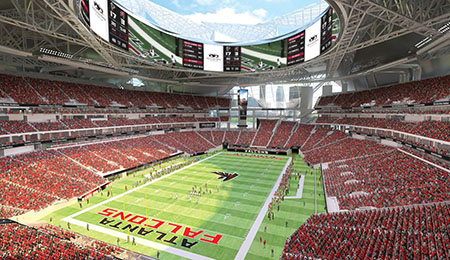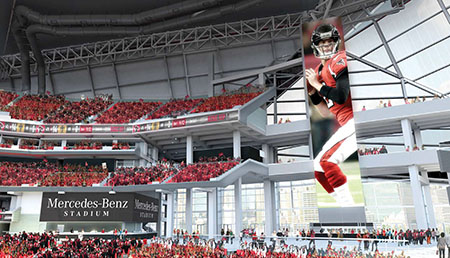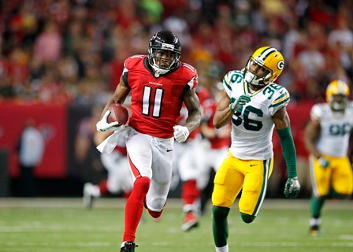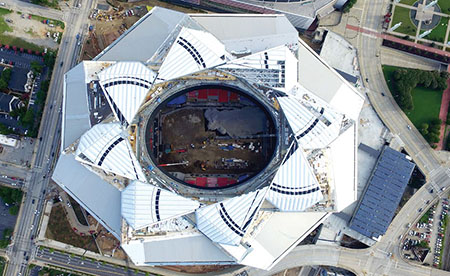Falcons Debut ‘Halo Board’
ATLANTA—After getting an eyeful of the massive main video boards that have been featured in new ballparks and stadia in recent years, sports fans had to wonder what the next step would be by the time Atlanta’s techno-cool Mercedes-Benz Stadium—which is billed as the most technologically advanced stadium in the world—opens this month.

The new Halo Board in Mercedes Benz Stadium in Atlanta is a 360-degree, 62,000-square-foot circular testament to technological fortitude.
The wonder was how much bigger a video display can get before it intrudes on the actual game that’s happening beneath it. But the crew and the contractors at AMB Group, the parent company of the NFL’s Atlanta Falcons, made that sentiment a moot point while going even bigger with a new idea.
For when the fans look toward the heavens when the Falcons need a dramatic score to win a game, they can send their prayers through Mercedes-Benz Stadium’s (here it comes…) “Halo Board.”
While video displays have been created in various shapes and sizes in recent years, this ensemble is a 360-degree, 62,000-square-foot circular testament to technological fortitude—under a roof that opens like a camera lens and is modeled after the Roman Pantheon. It will offer Falcon fans some interesting opportunities to share video and information, exercise the imagination and sell advertising.
NEW SENSATION
While the Halo Board in Mercedes-Benz Stadium isn’t the first circular-type screen—the outdoor board at Barclays Center in Brooklyn is similar, albeit much smaller and an irregular shape—it’s certainly something new.
“I haven’t seen anything of this magnitude,” said Tyler Jones, senior project manager with Daktronics, of the board that rests within the eight-section mega-circle of the roof that hangs under what’s known as the “Oculus.” He added that the company’s install outside of the Barclays Center gave it “something to draw on for the Atlanta project.”
Get the TV Tech Newsletter
The professional video industry's #1 source for news, trends and product and tech information. Sign up below.
That had to help the Brookings, S.D.- based company during the bidding process for the job, which commenced after the design of the stadium came back to the Falcons from HOK, a Kansas City, Mo.-based architectural firm.
“We were eventually awarded the job,” said Jones, “and there was a great deal of coordination with all of the people behind the team,” which included HOK Structural, then BuroHappold Engineering and IBM, the technical partner on the stadium that installed a passive optical network comprised of 3,770 miles of groundwork fiber cables.

The “Mega Column” vertical measures 101 feet tall by 71 feet wide.
Jones said Daktronics had “almost three dozen” workers on site; for the sake of comparison, that’s about two dozen more than the company needed five years ago to install the flat board in rightfield at Miami’s Marlins Park.
For Fox Sports, the Same Old Song is Still New
Julio Jones torched the Green Bay Packers for 180 yards and 2 TDs in the 2017 NFC Championship game.

The primary broadcasters for each conference in the NFL have a basic deal when a new stadium opens: If the new venue is in an American Football Conference (AFC) city, carrier CBS Sports oversees the new approach to the broadcasts; if it’s the NFC (National Football Conference), Fox Sports handles that duty.
That means that, in recent seasons, the gang at Fox Sports has had its hands full, with new stadia debuting in the Dallas, New York (where the NFC Giants share MetLife Stadium with the AFC Jets), San Francisco, Minnesota and now Atlanta markets.
“Each stadium represents a new hallmark,” said Michael Davies, senior vice president of field operations for the NFL on Fox.
And that can call for new angles to be taken when broadcasting from the new venues. “When you think about a facility, from a TV perspective, camera positions haven’t changed that much,” Davies said, “but your look angles have to be good, which can be a challenge with field level suites being built along the low angles and within the common viewing area,” which has been the case in Dallas and is now the case in Atlanta.
The other issue, he said, is that the stadium designers wants to put the fans right on top of the action, but can go about doing so in different ways.
“If you’re watching a game in Dallas”―which is home to two 160-foot by 72-foot Mitsubishi screens, which each span 60 yards―“you’re watching TV, basically,” he said with a laugh, noting that setup is said to be equivalent to a 68-inch screen in a living room. “In Atlanta, they are blending the TV experience and a football experience a little bit more.”
With the Halo Board in Mercedes Benz Stadium located just under the roof and the Mega Column providing an exclamation point in an end zone, Davies seemed mainly concerned with the positioning along the sidelines of the LED ribbon boards.
The key in these situations, he said, is for the builders to keep an eye cast to the future when designing the guts of new facility.
“These places will be around for the next 20-to-30 years,” he said. “For instance, there is very little copper in [Mercedes Benz Stadium]; it’s almost all fiber. There also have to be parking and loading areas for the trucks of the future.
“They have to be sure that they know that we have to prepare,” said Davies, “for what we don’t know yet.”
As far the construction of the Halo Board is concerned, its shape wasn’t quite the challenge one might think. “We can make the boards about any shape that is needed,” Jones said, “since 14.4 inches per square is our standard and we build around that. Within the Halo, the squares run 48 high and 896 wide,” totaling more than 43,000 squares.
Within the Halo, Daktronics also developed a 277V power option specific to the board, in lieu of the normal 120V power supply. “That allowed the Falcons to forgo using a number of smaller transformers,” said Jones, noting that it is embedded within the display.
The manufacturing process for the Halo Board began at Brookings headquarters in mid-October and ran until early February, and required the talents of more than 100 people to build; the install began in May, with that type of lead time necessary when Daktronics “had 616 pieces to mount in the stadium roof,” Jones said.
IN THE CORNER
Not lost in the buzz about the Halo Board is the “Mega Column,” which rests in the east corner of the stadium, by the massive end zone window that gives fans a panorama of the Atlanta skyline. The vertical display, which measures 101 feet tall by 71 feet wide, wraps around three of the four corners of that column.
“The information technology staff told me that the column has more square footage than the main boards in 17 other NFL stadiums,” Jones said, and it is fully visible to passersby outside the venue.
There is no end zone board on the east or west sides of Mercedes-Benz Stadium, which does include Daktronics ProRail ribbon boards on its north and south sides. They act as the railing for the upper deck and are topped with glass and handrails.
Mike Meglathery, senior project manager for broadcast systems integrator Diversified, described setting up the Halo Board as “technically challenging” for various reasons, not the least of which was obviously its size, which he termed “the equivalent of 12.5 video screens in a circle at 60 feet high, but it’s also a quarter-mile around.
“The biggest challenge was driving an image that can go all the way around it with pixel accuracy and synchronously,” he said. “We had to get all of the boards in sync.”
The Halo Board also required a “first of its kind graphics system” from Ross Video, the Tessera platform, which was developed for the Falcons and designed to offer enhanced IP video routing and connectivity.

The two million square-foot Mercedes Benz Stadium can hold up to 71,000 football fans. Modeled after the Roman Pantheon, it features a roof that opens like a camera lens.
Gus Drosos, technical principal at HOK, Kansas City, also noted the unusual approach that all involved had to take at Mercedes-Benz Stadium. “We had a tall structure” to address, meaning the 14.5-acre roof “was 198 feet above the ground. It became apparent that if we used that real estate to integrate a smooth ellipse, we could create a ‘theatre-in-the-round’ to give the fans a full immersive experience.”
Drosos said that, initially, what became the Halo Board “was segmented, but as we worked with the Falcons, it became apparent that making it round would work.” Thus was the establishmsent of a 70-foot tall board, “with a 10-foot gap on top until you hit the flat roof would work.
“We saw the Halo Board as an opportunity to take the scoreboard out of the line of sight,” he said, and the Falcons “were excited about the possibilities of the board, because the team’s video operators can drive a car or bounce a ball around it. No one has done this, so there is an evolution of ideas going on. The potential for what they can do with this board is unprecedented.”
THE POSSIBILITIES
Drosos also mentioned a social media angle for the display. With a new stadium that features 1,800 wireless access points that allow 75,000 fans to stream concurrently, “wouldn’t it be cool if the team [and the NFL, which would have to set up a protocol] let the fans use social media and integrate them into the Halo Board, or offer them specials?” he mused. “What does this present for other activities? Can you play video games on it? Could you potentially put something on 3D on it and give fans special glasses, if the technology can allow that?”
Jones noted that “the most important thing I learned from this project was that the communication between the architects and designers, as well as the contractors and those who worked in manufacturing, was especially important. That’s what made this happen.
“It’s pushed us forward,” he added, “because there will be more interest in this type of video application. Stadiums are trying to push the envelope and we’re anticipating more interest in this type of design as we move forward.”
Meglathery agreed. “It’s stunning what it does and it will elevate the in-stadium fan experience. This the showpiece video board for America at this point.”
Mark R. Smith has covered the media industry for a variety of industry publications, with his articles for TV Technology often focusing on sports. He’s written numerous stories about all of the major U.S. sports leagues.
Based in the Baltimore-Washington area, the byline of Smith, who has also served as the long-time editor-in-chief for The Business Monthly, Columbia, Md., initially appeared in TV Technology and in another Futurenet publication, Mix, in the late ’90s. His work has also appeared in numerous other publications.

